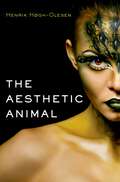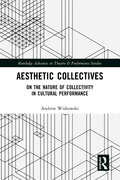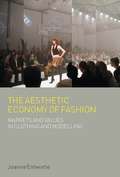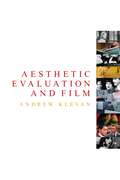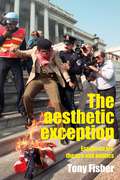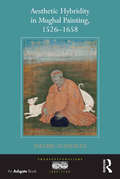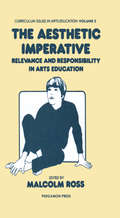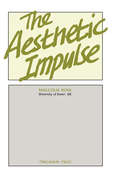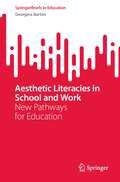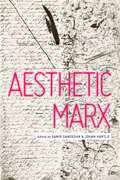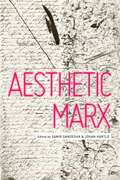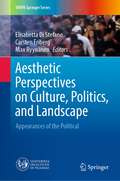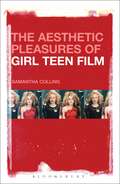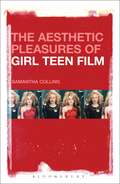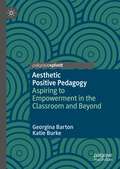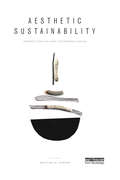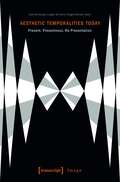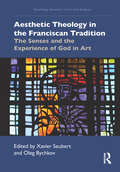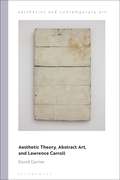- Table View
- List View
The Aesthetic Animal
by Henrik Hogh-OlesenThe Aesthetic Animal answers the ultimate questions of why we adorn ourselves, embellish our things and surroundings, and produce art, music, song dance, and fiction. Humans are aesthetic animals that spend vast amounts of time and resources on seemingly useless aesthetic activities. However, nature would not allow a species to waste precious time and effort on activities completely unrelated to survival, reproduction, and the well-being of that species. Consequently, the aesthetic impulse must have some important biological functions. A number of observations indicate that the aesthetic impulse is an inherent part of human nature, and therefore a primary impulse in its own right with several important functions: The aesthetic impulse may guide us toward what is biologically good for us, and help us choose the right fitness enhancing items in our surroundings. It is a valid individual fitness indicator as well as a unifying social group marker, and aesthetically skilled individuals get more mating possibilities, higher status and more collaborative offers. The book is written in a lively and entertaining tone, with beautiful color illustrations. It covers a wide field of aesthetic behaviors from cave art, graffiti, tattoos, and piercings over fashion, design, music, song, and dance. It presents an original and comprehensive synthesis of the empirical field, synthesizing data from archeology, cave art, anthropology, biology, ethology, behavioral- and evolutionary psychology and neuro-aesthetics. It is a must-read for people interested in biology, psychology, anthropology, architecture, design, fashion, body culture, art, and the evolution of aesthetics.
Aesthetic Collectives: On the Nature of Collectivity in Cultural Performance (Routledge Advances in Theatre & Performance Studies)
by Andrew WiskowskiThis book focuses attention on groups of performing people that are unique aesthetic objects, the focus of an artist’s vision, but at the same time a collective being; a singular, whole mass that exists and behaves like an individual entity. This text explores this unique experience, which is far from rare or special. Indeed, it is pervasive, ubiquitous and has, since the dawn of performance, been with us. Surveying installation art from Vanessa Beecroft & Kanye West, Greek tragedy, back-up dancing groups and even the mass dance of clubbing crowds, this text examines and names this phenomenon: Aesthetic Collectives. Drawing on a range of methods of investigation spanning performance studies, acting theory, studies of atmosphere and affect and sociology it presents an intervention in the literature for something that has long deserved its own attention. This book will be of great interest to scholars, students and practitioners in performance studies, theatre, live art, sociology (particularly of groups and subcultures), cultural studies and cultural geography.
Aesthetic Collectives: On the Nature of Collectivity in Cultural Performance (Routledge Advances in Theatre & Performance Studies)
by Andrew WiskowskiThis book focuses attention on groups of performing people that are unique aesthetic objects, the focus of an artist’s vision, but at the same time a collective being; a singular, whole mass that exists and behaves like an individual entity. This text explores this unique experience, which is far from rare or special. Indeed, it is pervasive, ubiquitous and has, since the dawn of performance, been with us. Surveying installation art from Vanessa Beecroft & Kanye West, Greek tragedy, back-up dancing groups and even the mass dance of clubbing crowds, this text examines and names this phenomenon: Aesthetic Collectives. Drawing on a range of methods of investigation spanning performance studies, acting theory, studies of atmosphere and affect and sociology it presents an intervention in the literature for something that has long deserved its own attention. This book will be of great interest to scholars, students and practitioners in performance studies, theatre, live art, sociology (particularly of groups and subcultures), cultural studies and cultural geography.
The Aesthetic Economy of Fashion: Markets and Value in Clothing and Modelling (Dress, Body, Culture)
by Joanne EntwistleFashion is bound up with promoting the 'new', concerned with constantly changing aesthetics. The favoured styles or looks of a season arise out of the work of a vast range of different actors who collectively produce, select, distribute and promote the new ideals, before moving on to next season. How, then, are fashionable commodities stabilized long enough for them to be selected, distributed and sold? Since there are few studies that actually examine the work that goes on inside the world of fashion, we know little about these processes. This book addresses this gap in our knowledge by examining how aesthetic products are defined, distributed and valued. It focuses attention on the work of some of the market agents, particularly model agents or 'bookers' and fashion buyers, shaping the aesthetics inside their markets. In analysing their work, Entwistle develops a theoretical framework for understanding the distinctive features of aesthetic marketplaces and the aesthetic calculations within them.
Aesthetic evaluation and film
by Andrew KlevanThis book provides an in-depth, holistic examination of evaluative aesthetics and criticism as they apply to film. Organised around the explanation of key concepts, it illuminates connections between the work of philosophers, theorists and critics, and demonstrates the evaluation of form through the close analysis of film sequences. The book advocates that aesthetic evaluation should be flexibly informed by a cluster of concerns including medium, convention, prominence, pattern and relation; and rather than privileging a particular theory or film style, it models a type of approach, attention, process and discourse. Suitable for students of film studies and philosophical aesthetics at both undergraduate and postgraduate levels, Aesthetic evaluation and film also provides a framework for academics researching or teaching in the area. At the same time, the crisp and lucid style will make the book accessible to a wider readership.
Aesthetic evaluation and film (Current Practices in Ophthalmology)
by Andrew KlevanThis book provides an in-depth, holistic examination of evaluative aesthetics and criticism as they apply to film. Organised around the explanation of key concepts, it illuminates connections between the work of philosophers, theorists and critics, and demonstrates the evaluation of form through the close analysis of film sequences. The book advocates that aesthetic evaluation should be flexibly informed by a cluster of concerns including medium, convention, prominence, pattern and relation; and rather than privileging a particular theory or film style, it models a type of approach, attention, process and discourse. Suitable for students of film studies and philosophical aesthetics at both undergraduate and postgraduate levels, Aesthetic evaluation and film also provides a framework for academics researching or teaching in the area. At the same time, the crisp and lucid style will make the book accessible to a wider readership.
The aesthetic exception: Essays on art, theatre, and politics
by Tony FisherThe aesthetic exception theorises anew the relation between art and politics. It challenges critical trends that discount the role of aesthetic autonomy, to impulsively reassert art as an effective form of social engagement. But it equally challenges those on the flipside of the efficacy debate, who insist that art’s politics is limited to a recondite space of ‘autonomous resistance’. The book shows how each side of the efficacy debate overlooks art’s exceptional status and its social mediations. Mobilising philosophy and cultural theory, and employing examples from visual art, performance, and theatre, it proposes four alternative tests to ‘effect’ to offer a nuanced account of art’s political character. Those tests examine how art relates to politics as a practice that articulates its historical conjuncture, and how it prefigures the ‘new’ through simulations capable of activating the political life of the spectator.
The aesthetic exception: Essays on art, theatre, and politics
by Tony FisherThe aesthetic exception theorises anew the relation between art and politics. It challenges critical trends that discount the role of aesthetic autonomy, to impulsively reassert art as an effective form of social engagement. But it equally challenges those on the flipside of the efficacy debate, who insist that art’s politics is limited to a recondite space of ‘autonomous resistance’. The book shows how each side of the efficacy debate overlooks art’s exceptional status and its social mediations. Mobilising philosophy and cultural theory, and employing examples from visual art, performance, and theatre, it proposes four alternative tests to ‘effect’ to offer a nuanced account of art’s political character. Those tests examine how art relates to politics as a practice that articulates its historical conjuncture, and how it prefigures the ‘new’ through simulations capable of activating the political life of the spectator.
Aesthetic Hybridity in Mughal Painting, 1526-1658 (Transculturalisms, 1400-1700)
by Valerie GonzalezThe first specialized critical-aesthetic study to be published on the concept of hybridity in early Mughal painting, this book investigates the workings of the diverse creative forces that led to the formation of a unique Mughal pictorial language. Mughal pictoriality distinguishes itself from the Persianate models through the rationalization of the picture’s conceptual structure and other visual modes of expression involving the aesthetic concept of mimesis. If the stylistic and iconographic results of this transformational process have been well identified and evidenced, their hermeneutic interpretation greatly suffers from the neglect of a methodologically updated investigation of the images’ conceptual underpinning. Valerie Gonzalez addresses this lacuna by exploring the operations of cross-fertilization at the level of imagistic conceptualization resulting from the multifaceted encounter between the local legacy of Indo-Persianate book art, the freshly imported Persian models to Mughal India after 1555 and the influx of European art at the Mughal court in the sixteenth and seventeenth centuries. The author's close examination of the visuality, metaphysical order and aesthetic language of Mughal imagery and portraiture sheds new light on this particular aspect of its aesthetic hybridity, which is usually approached monolithically as a historical phenomenon of cross-cultural interaction. That approach fails to consider specific parameters and features inherent to the artistic practice, such as the differences between doxis and praxis, conceptualization and realization, intentionality and what lies beyond it. By studying the distinct phases and principles of hybridization between the variegated pictorial sources at work in the Mughal creative process at the successive levels of the project/intention, the practice/realization and the result/product, the author deciphers the modalities of appropriation and manipulation of the heterogeneous elements. Her unique
Aesthetic Hybridity in Mughal Painting, 1526-1658 (Transculturalisms, 1400-1700)
by Valerie GonzalezThe first specialized critical-aesthetic study to be published on the concept of hybridity in early Mughal painting, this book investigates the workings of the diverse creative forces that led to the formation of a unique Mughal pictorial language. Mughal pictoriality distinguishes itself from the Persianate models through the rationalization of the picture’s conceptual structure and other visual modes of expression involving the aesthetic concept of mimesis. If the stylistic and iconographic results of this transformational process have been well identified and evidenced, their hermeneutic interpretation greatly suffers from the neglect of a methodologically updated investigation of the images’ conceptual underpinning. Valerie Gonzalez addresses this lacuna by exploring the operations of cross-fertilization at the level of imagistic conceptualization resulting from the multifaceted encounter between the local legacy of Indo-Persianate book art, the freshly imported Persian models to Mughal India after 1555 and the influx of European art at the Mughal court in the sixteenth and seventeenth centuries. The author's close examination of the visuality, metaphysical order and aesthetic language of Mughal imagery and portraiture sheds new light on this particular aspect of its aesthetic hybridity, which is usually approached monolithically as a historical phenomenon of cross-cultural interaction. That approach fails to consider specific parameters and features inherent to the artistic practice, such as the differences between doxis and praxis, conceptualization and realization, intentionality and what lies beyond it. By studying the distinct phases and principles of hybridization between the variegated pictorial sources at work in the Mughal creative process at the successive levels of the project/intention, the practice/realization and the result/product, the author deciphers the modalities of appropriation and manipulation of the heterogeneous elements. Her unique
The Aesthetic Imperative: Relevance and Responsibility in Arts Education
by Malcolm RossThe Aesthetic Imperative: Relevance and Responsibility in Arts Education is a collection of papers that covers various concerns in assessment in the context of arts education. In the first chapters, the text examines the predicament of the arts. The next two chapters relate assessment in the context of esthetic education and evaluation in the arts. Chapter 4 talks about the assessment of esthetic developments in the visual mode. The fifth chapter details the importance of evaluating the quality of the test itself, while the sixth chapter covers the conflict between schools and art education. In Chapter 7, the book talks about treating English as an art. The eighth chapter discusses the relevance of art in education, while the ninth chapter provides a conclusive discussion on art education. The text will be of great interest to readers who are concerned with the status of art as part of a school curriculum.
The Aesthetic Impulse
by Malcolm RossThe Aesthetic Impulse explains aesthetic as describing a significant area of the school curriculum that would include but not be confined to the creative arts. Organized into 10 chapters, this book begins with a discussion on arts education. Subsequent chapters explain art, sensibility, aesthetics, and the vernacular principle. The concept of arts education as cultural education, which means responding to the young's needs to generate individual and group identity, is also described. Other chapters explore the aesthetic curriculum and assessment of aesthetic development.
Aesthetic Literacies in School and Work: New Pathways for Education (SpringerBriefs in Education)
by Georgina BartonThis book argues the importance of aesthetic literacies in learning and teaching in schools for future work. The study of aesthetics is critical in today’s learning, due to the increasingly complex ways in which we communicate meaning, such as through the presentation of texts and objects. The book provides educators, pre-service teachers, and students an in-depth understanding of aesthetic literacies in innovative spaces, including in philosophical literature, environmental spaces, curricula and classrooms. Using various theoretical frames from both the arts and literacy fields, this book shares relevant pedagogies, theorisations and contexts where aesthetic literacies are at the core of learning. It emphasises how improved knowledge of aesthetics and quality experiences in beauty are vital in aiding students and young children develop the necessary resilience and tolerance needed in today’s uncertain world.
Aesthetic Marx
by Samir Gandesha Johan F. HartleThe whole of Marx's project confronts the narrow concerns of political philosophy by embedding it in social philosophy and a certain understanding of the aesthetic. From those of aesthetic production to the "poetry of the future" (as Marx writes in the Eighteenth Brumaire), from the radical modernism of bourgeois development to the very idea of association (which defined one of the main lines of tradition in the history of aesthetics), steady references to Dante, Shakespeare and Goethe, and the idea that bourgeois politics is nothing but a theatrical stage: the aesthetic has a prominent place in the constellation of Marx's thought. This book offers an original and challenging study of both Marx in the aesthetic, and the aesthetic in Marx. It differs from previous discussions of Marxist aesthetic theory as it understands the works of Marx themselves as contributions to thinking the aesthetic. This is an engagement with Marx's aesthetic that takes into account Marx's broader sense of the aesthetic, as identified by Eagleton and Buck-Morss – as a question of sense perception and the body. It explores this through questions of style and substance in Marx and extends it into contemporary questions of how this legacy can be perceived or directed analytically in the present. By situating Marx in contemporary art debates this volume speaks directly to lively interest today in the function of the aesthetic in accounts of emancipatory politics and is essential reading for researchers and academics across the fields of political philosophy, art theory, and Marxist scholarship.
Aesthetic Marx
by Samir Gandesha Johan F. HartleThe whole of Marx's project confronts the narrow concerns of political philosophy by embedding it in social philosophy and a certain understanding of the aesthetic. From those of aesthetic production to the "poetry of the future" (as Marx writes in the Eighteenth Brumaire), from the radical modernism of bourgeois development to the very idea of association (which defined one of the main lines of tradition in the history of aesthetics), steady references to Dante, Shakespeare and Goethe, and the idea that bourgeois politics is nothing but a theatrical stage: the aesthetic has a prominent place in the constellation of Marx's thought. This book offers an original and challenging study of both Marx in the aesthetic, and the aesthetic in Marx. It differs from previous discussions of Marxist aesthetic theory as it understands the works of Marx themselves as contributions to thinking the aesthetic. This is an engagement with Marx's aesthetic that takes into account Marx's broader sense of the aesthetic, as identified by Eagleton and Buck-Morss – as a question of sense perception and the body. It explores this through questions of style and substance in Marx and extends it into contemporary questions of how this legacy can be perceived or directed analytically in the present. By situating Marx in contemporary art debates this volume speaks directly to lively interest today in the function of the aesthetic in accounts of emancipatory politics and is essential reading for researchers and academics across the fields of political philosophy, art theory, and Marxist scholarship.
Aesthetic Perspectives on Culture, Politics, and Landscape: Appearances of the Political (UNIPA Springer Series)
by Elisabetta Di Stefano Carsten Friberg Max RyynänenThis book investigates how we are involved in politically informed structures and how they appear to us. Following different approaches in contemporary aesthetics and cultural philosophy, such as everyday aesthetics, atmosphere and aestheticization, the contributions explore how embedded powers in politics, education, democracy, and landscape are analyzed through aesthetics.
The Aesthetic Pleasures of Girl Teen Film
by Samantha CollingWhat is 'fun' about the Hollywood version of girlhood? Through re-evaluating notions of pleasure and fun, The Aesthetic Pleasures of Girl Teen Film forms a study of Hollywood girl teen films between 2000-2010. By tracing the aesthetic connections between films such as Mean Girls (Waters, 2004), Hairspray (Shankman, 2007), and Easy A (Gluck, 2010), the book articulates the specific types of pleasure these films offer as a means to understand how Hollywood creates gendered ideas of fun. Rather than condemn these films as 'guilty pleasures' this book sets out to understand how they are designed to create experiences that feel as though they express desires, memories, or fantasies that girls supposedly share in common. Providing a practical model for a new approach to cinematic pleasures The Aesthetic Pleasures of Girl Teen Film proposes that these films offer a limited version of girlhood that feels like potential and promise but is restricted within prescribed parameters.
The Aesthetic Pleasures of Girl Teen Film
by Samantha CollingWhat is 'fun' about the Hollywood version of girlhood? Through re-evaluating notions of pleasure and fun, The Aesthetic Pleasures of Girl Teen Film forms a study of Hollywood girl teen films between 2000-2010. By tracing the aesthetic connections between films such as Mean Girls (Waters, 2004), Hairspray (Shankman, 2007), and Easy A (Gluck, 2010), the book articulates the specific types of pleasure these films offer as a means to understand how Hollywood creates gendered ideas of fun. Rather than condemn these films as 'guilty pleasures' this book sets out to understand how they are designed to create experiences that feel as though they express desires, memories, or fantasies that girls supposedly share in common. Providing a practical model for a new approach to cinematic pleasures The Aesthetic Pleasures of Girl Teen Film proposes that these films offer a limited version of girlhood that feels like potential and promise but is restricted within prescribed parameters.
Aesthetic Positive Pedagogy: Aspiring to Empowerment in the Classroom and Beyond
by Georgina Barton Katie BurkeThis book introduces and explores a new pedagogical approach, Aesthetic Positive Pedagogy (APP), for teachers and students in a variety of educational contexts. The book is built on the need for educational institutions and communities to seriously consider a strong positive approach to learning and teaching, ultimately leading to a better world. Based on pre-existing philosophies such as positive pedagogy and critical pedagogy, APP encourages teachers to carefully consider their language use as well as other modal resources in the classroom. Using aesthetic experience as a core to learning, teachers can embed an approach to learning and teaching that supports wellbeing and resilience as well as caring and compassionate citizenship in their students. The authors outline what an APP approach to learning and teaching looks, feels and sounds like in different educational contexts such as in schools and higher education, and explore how it might be implemented in face-to-face as well as online learning. The book’s findings will apply to postgraduate students and academics in education and the creative arts, as well as teachers and leaders in schools.
Aesthetic Sustainability: Product Design and Sustainable Usage (Routledge Studies in Sustainability)
by Kristine H. HarperWhy do we readily dispose of some things, whereas we keep and maintain others for years, despite their obvious wear and tear? Can a greater understanding of aesthetic value lead to a more strategic and sustainable approach to product design? Aesthetic Sustainability: Product Design and Sustainable Usage offers guidelines for ways to reduce, rethink, and reform consumption. Its focus on aesthetics adds a new dimension to the creation, as well as the consumption, of sustainable products. The chapters offer innovative ways of working with expressional durability in the design process. Aesthetic Sustainability: Product Design and Sustainable Usage is related to emotional durability in the sense that the focus is on the psychological and sensuous bond between subject and object. But the subject–object connection is based on more than emotions: aesthetically sustainable objects continuously add nourishment to human life. This book explores the difference between sentimental value and aesthetic value, and it offers suggestions for operational approaches that can be implemented in the design process to increase aesthetic sustainability. This book also offers a thorough presentation of aesthetics, focusing on the correlation between the philosophical approach to the aesthetic experience and the durable design experience. The book is of interest to students and scholars working in the fields of design, arts, the humanities and social sciences; additionally, it will speak to designers and other professionals with an interest in sustainability and aesthetic value.
Aesthetic Sustainability: Product Design and Sustainable Usage (Routledge Studies in Sustainability)
by Kristine H. HarperWhy do we readily dispose of some things, whereas we keep and maintain others for years, despite their obvious wear and tear? Can a greater understanding of aesthetic value lead to a more strategic and sustainable approach to product design? Aesthetic Sustainability: Product Design and Sustainable Usage offers guidelines for ways to reduce, rethink, and reform consumption. Its focus on aesthetics adds a new dimension to the creation, as well as the consumption, of sustainable products. The chapters offer innovative ways of working with expressional durability in the design process. Aesthetic Sustainability: Product Design and Sustainable Usage is related to emotional durability in the sense that the focus is on the psychological and sensuous bond between subject and object. But the subject–object connection is based on more than emotions: aesthetically sustainable objects continuously add nourishment to human life. This book explores the difference between sentimental value and aesthetic value, and it offers suggestions for operational approaches that can be implemented in the design process to increase aesthetic sustainability. This book also offers a thorough presentation of aesthetics, focusing on the correlation between the philosophical approach to the aesthetic experience and the durable design experience. The book is of interest to students and scholars working in the fields of design, arts, the humanities and social sciences; additionally, it will speak to designers and other professionals with an interest in sustainability and aesthetic value.
Aesthetic Temporalities Today: Present, Presentness, Re-Presentation (Image #185)
by Gabriele Genge Ludger Schwarte Angela SterckenThis volume is dedicated to the interrelation between temporality and representation. It presumes that time cannot be conceived of as an abstract chronometric order, but that it is referring to materiality, being measured, represented, expressed, recognized, experienced and evaluated, and therefore is always closely related to cultural contexts of perception and evaluation. The contributions from various disciplines are dedicated to the present and its plural conditions and meanings. They provide insights into the state of research with special emphasis on the global present as well as on art and aesthetics from the 18th century until today. The anthology includes contributions by Mieke Bal, Stefan Binder, Maximilian Bergengruen, Iris Därmann, Gabriele Genge, Boris Roman Gibhardt, Boris Groys, Maria Muhle, Johannes F. Lehmann, Nkiru Nzegwu, Francesca Raimondi, Christine Ross, Ludger Schwarte, Angela Stercken, Samuel Strehle, Timm Trausch, Patrick Stoffel, and Christina Wessely.
Aesthetic Theology in the Franciscan Tradition: The Senses and the Experience of God in Art (Routledge Research in Art and Religion)
by Xavier Seubert Oleg BychkovThe book investigates the aesthetic theology embedded in the Franciscan artistic tradition. The novelty of the approach is in applying concepts gleaned from Franciscan textual sources to create a deeper understanding of how art in all its sensual forms was foundational to the Franciscan milieu. Chapters range from studies of statements about aesthetics and the arts in theological textual sources to examples of visual, auditory, and tactile arts communicating theological ideas found in texts. The essays cover not only European art and textual sources, but also Franciscan influences in the Americas found in both texts and artifacts.
Aesthetic Theology in the Franciscan Tradition: The Senses and the Experience of God in Art (Routledge Research in Art and Religion)
by Xavier Seubert Oleg BychkovThe book investigates the aesthetic theology embedded in the Franciscan artistic tradition. The novelty of the approach is in applying concepts gleaned from Franciscan textual sources to create a deeper understanding of how art in all its sensual forms was foundational to the Franciscan milieu. Chapters range from studies of statements about aesthetics and the arts in theological textual sources to examples of visual, auditory, and tactile arts communicating theological ideas found in texts. The essays cover not only European art and textual sources, but also Franciscan influences in the Americas found in both texts and artifacts.
Aesthetic Theory, Abstract Art, and Lawrence Carroll (Aesthetics and Contemporary Art)
by David CarrierBoldly developing the central traditions of American modernist abstraction, Lawrence Carroll's paintings engage with a fundamental issue of aesthetic theory, the nature of the medium of painting, in highly original, frequently extraordinarily successful ways. Aesthetic Theory, Abstract Art, and Lawrence Carroll explains how he understands the medium of painting; shows what his art says about the identity of painting as an art; discusses the place of his paintings in the development of abstraction; and, finally, offers an interpretation of his art. The first monograph devoted to him, this philosophical commentary employs the resources of analytic aesthetics. Art historians trace the development of art, explaining how what came earlier yields to what comes later. Taking for granted that the artifacts they describe are artworks, art historians place them within the history of art. Philosophical art writers define art, explain why it has a history and identify its meaning. Pursuing that goal, Aesthetic Theory, Abstract Art, and Lawrence Carroll roams freely across art history, focused at some points on the story of old master painting and sometimes on the history of modernism, but looking also to contemporary art, in order to provide the fullest possible philosophical perspective on Carroll's work.
